Research on the Application of Explosive Network in the Shaped Charge Warhead
2011-07-25XULixin徐立新LIUJianrong刘建荣ZHAOGuangbo赵广波YUChengda于成大LIXin李昕ZHANGGuowei张国伟
XU Li-xin(徐立新),LIU Jian-rong(刘建荣),ZHAO Guang-bo(赵广波),YU Cheng-da(于成大),LI Xin(李昕),ZHANG Guo-wei(张国伟)
(1.Unit No.63961,PLA,Beijing 100012,China;2.School of Mechatronic Engineering,North University of China,Taiyuan 030051,Shanxi,China;3.Jilin Military Representative Office,Jilin 132021,Jilin,China)
Introduction
Many detonation systems in shaped charge warheads use traditional cover method(Fig.1)in order to improve the detonation wave and enhance the penetrating power of shaped charge warhead.It is featured by using sub-grain and cover in charge structure to change the propagation direction of detonation wave and the detonation wave form to increase the pressure on shaped charge liner,therefore improving the explosive loading and the velocity gradient on basis of jet velocity,quality and the other elements for improved penetration power.However,the following problems exist in this method[1]:
1)Large sizes of cover and sub-grain result in the reduction of the explosive loading coefficient which seriously affects the penetrating power;
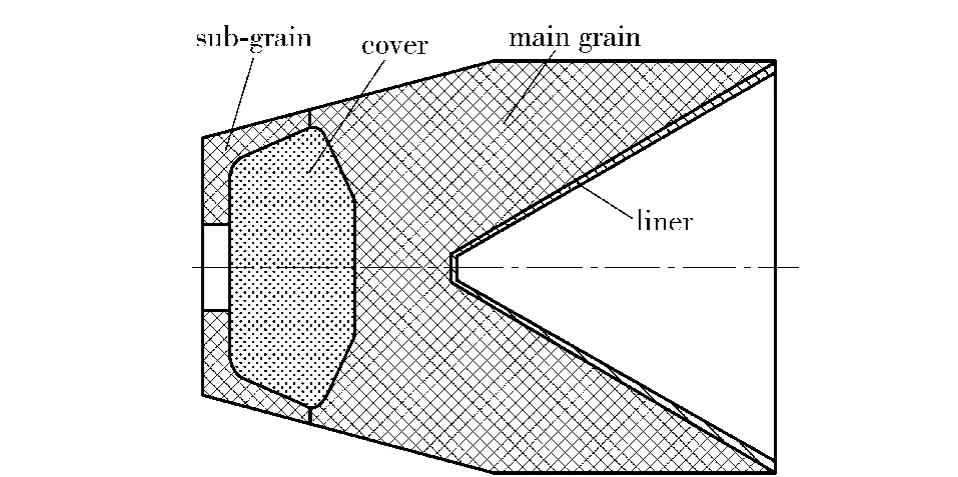
Fig.1 Structure of shaped charge warhead with cover and sub-grain
2)In the process of propagation of detonation wave in the sub-grains,the detonation wave interferes with and reflects from the clapboard of which structural size and material density also affect the detonation parameters.Since the cover may cause the detonation wave to be asymmetrical and instable,the detonation waveform in the main grain can be accurately controlled,leading to the instability of or even decrease in penetration power;
3)The non-concentricity among sub-grain,cover,main grain,shaped charge liner and other elements directly affects the axial symmetry of detonation wave.As a result,the jet flows are not well concentrated on the symmetry axis,which cause the deflection and distortion in connection and lead to the instability of penetration performance;
4)The increased size of warhead structure for cover adding result in increasing the weight of warhead;
5)Complexity of charge process is increased,etc.
To address the above problems,a multi-point synchronous explosive network technology is used as a shaped charge warhead detonation mode,as shown in Fig.2.The technology has the following advantages:
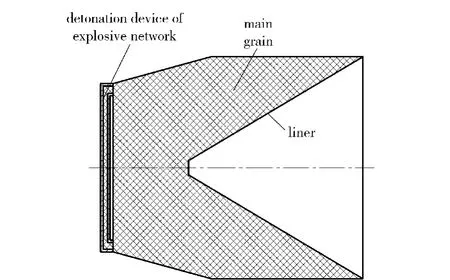
Fig.2 Structure of shaped charge warhead with synchronous explosive network
(1)Miniaturization.The original cover and subgrains are replaced by a synchronous explosive network so that its size can be reduced to 1/10 of its original one or even smaller,decreasing HEAT volume and weight significantly;
(2)Accuracy control of detonation wave in a small space,and the significantly improved power of the warhead without the increase in or with the reduction in the charge amount of the main grain;
(3)Simple charging process and promoted stability of penetration,etc.The application of multi-point synchronous explosive network technology[2-5]in the shaped charge warhead is studied in this paper.
1 Basic Description of Synchronous Explosive Network Technology
The synchronous explosive network[6-8]is a kind of explosive network with single-point input and synchronous multi-supported output function[9].According to the different carriers,the network can be divided into rigid and flexible types.The rigid explosive network is a groove network taking rigid substrates as a carrier.It can be divided into surface and line networks according to the geometric distribution of output points,and it can be also divided into center type and eccentric networks according to the relative positions of output points and input points.
The application of synchronous explosive network technology on basis of groove typed network with rigid substrate carrier is researched in the paper.This technology is characterized by small synchronous detonation time error,ease of processing and charging,possibility of small-scale integration,standardization,serialization and so on.Owing to the complete and regular output waveform,it is easy to be assembled with main charge,and is suitable for the charging of shaped charge warheads with different calibers and specifications.
2 Acquisition ofIdealDetonation Waveform
In the course of applied study of shaped charge warhead detonated by synchronous explosive network technology,the reasonable characteristic parameters of explosive network device are determined according to the size of charging structure including shaped charge liner and main grain.The device can help to obtain the ideal symmetrical detonation waveform to improve the jet penetration power and its stability.
An ideal detonation waveform is required to meet the following characteristics:
1)Reduce the angle between detonation wave front and shaped charge liner wall;
2)Increase the range of sub detonation wave sweeping on shaped charge liner walls;
3)Ensure the top of liner first to be crushed;
4)Ensure the symmetry of detonation wave.
In order to obtain the ideal detonation wave,a detonation mode of single-input/multi-output rigid synchronous explosive network is designed for a penetration warhead in comprehensive considering of coupling among liner structure,charging size and detonation waves,and its numerical simulation is carried out.The results are shown in Fig.3.

Fig.3 A“bell-shaped”detonation wave formed by detonation of synchronous explosive network
The simulation results show that the detonation through the synchronous explosive network forms a“bell-shaped”detonation wave before reaching the top of liner,which has the characteristics of ideal waveform.
According to the optimized results of simulation,a synchronous explosive network prototype is developed.The relative detonation waveform is test based on a certain shaped charge warhead.The test results are shown in Fig.4.

Fig.4 Test results of detonation waveform
It can be seen from Fig.4 that the adjustment of synchronous explosive network on the detonation wave is obvious,and the ideal detonation wave is obtained,indicating the possibility of adjusting the detonation wave by the method.
3 Performance Comparison Experiment
3.1 Experimental Layout and Requirements
In order to verify the efficiency of the single-input/multi-output rigid synchronous explosive network device(Fig.5)on the improved detonation reliability and the penetration depth and stability of the shaped charge warhead,static jet penetration test of a shaped charge warhead(Fig.5)is performed,and the experimental layout is shown in Fig.6.To make the test results comparable,the synchronous explosive network device is designed based on the original structural parameters of main grain and liner.
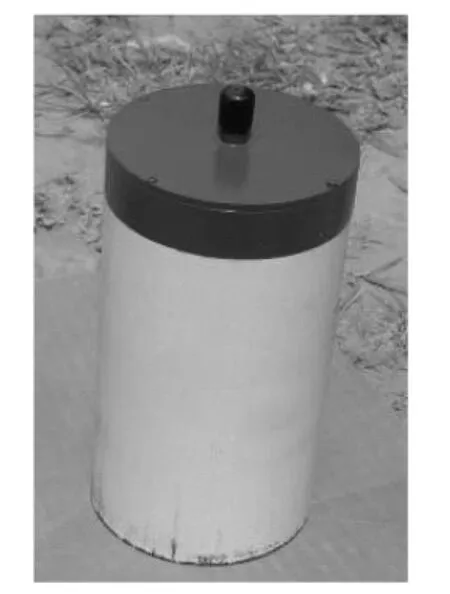
Fig.5 Combination of single-input/multi-output rigid synchronous explosive network device and main grain

Fig.6 Static jet penetration test layout
A 2.22d-diameter(dis the diameter of liner)45#round steel ingot is used in the experiment.A target plate consists of 6 steel ingots with 2.22d,1.11dand 0.56dthicknesses of which has two pieces of each thick ingot.The dimensions of target plate are shown in Fig.7,and its thickness is 7.78d.In order to ensure the horizontal placement of target plate and prevent it from recoiling,the target plate is placed on large base steel with thickness of 0.39d(Fig.7).
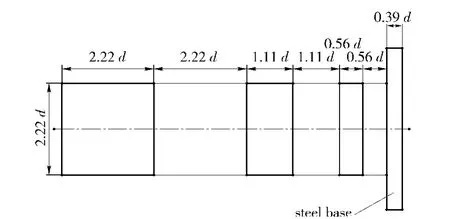
Fig.7 Structure and dimensions of target plate
To ensure that the results in this study are convincing and comparable to the original static penetration test results,the above test is conducted by using original static penetration test conditions.
3.2 Experimental Results and Analysis
3.2.1 Experimental Result
The static jet penetration test results of single-input/multi-output rigid synchronous explosive network detonation are shown in Tab.1,Fig.8 and Fig.9.

Tab.1 Static jet penetration test results of explosive network detonation
The static detonation test results of the original shaped charge warhead with cover and sub-grain are shown in Tab.2.
3.2.2 Analysis
1)From the test results in Tab.1,it can be seen that the synchronous explosive network device as a detonation mode can generate normally detonates the shaped charge warhead;

Fig.8 Jet penetration resultof explosive network detonation
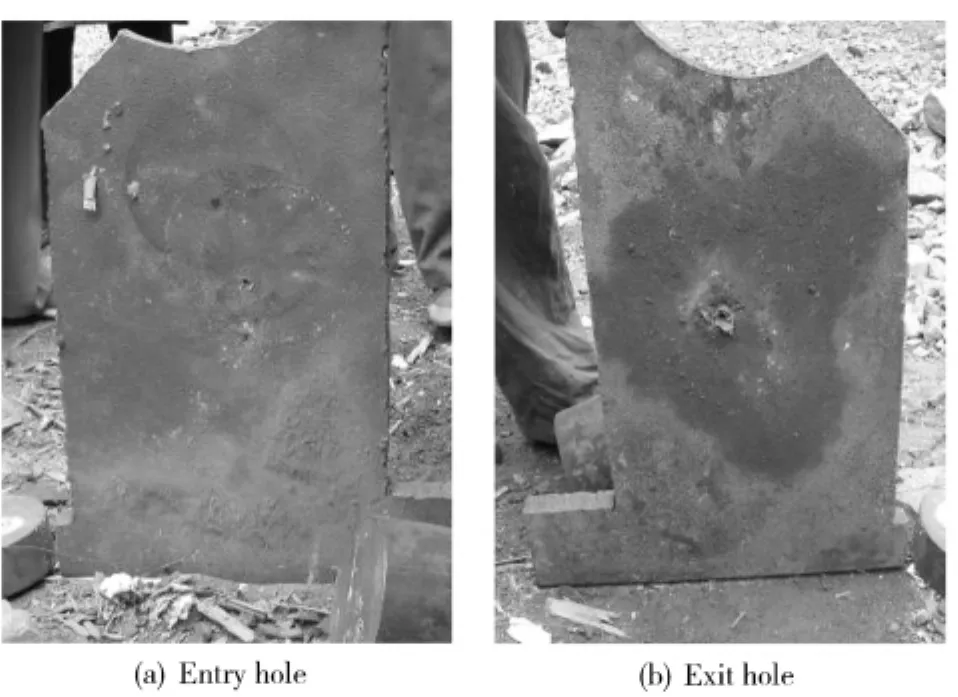
Fig.9 Jet perforation in steel base
2)From the test results in Tab.1 and Tab.2,it is known that the shaped charge warhead detonated using the synchronous explosive network device has the jet penetration power of 7.63d-8.17dand the average penetrable depth of 8.00d.While the original shaped charge warhead with cover and sub-grain detonation method has the jet penetration power of 3.96d-7.39dand the average penetrable depth of 6.22d.Average penetrable depth is increased by 28.6%using the synchronous explosive network device;
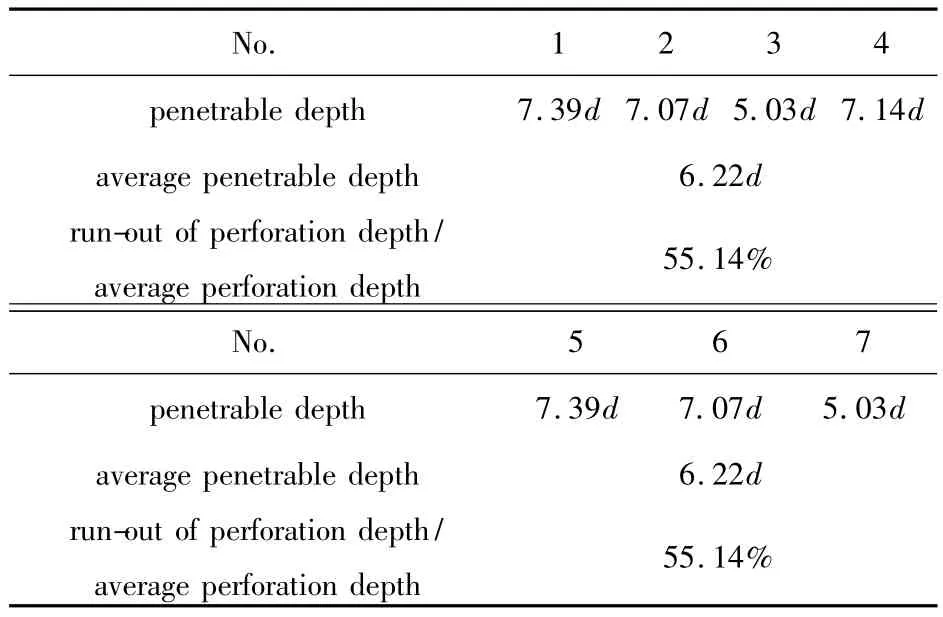
Tab.2 Test results of original shaped charge warhead
3)From the test results in Tab.1 and 2,the ratio of penetrable depth run-out and average penetrable depth is 6.75%for shaped charge warhead with detonation mode of synchronous explosive network device.While the original shaped charge warhead with cover and sub-grain has the ratio of penetrable depth run-out and average penetrable depth is 55.14%.The ratio is decreased to 87.8%using network device;
4)Test results of detonation wave in Fig.4 show that the synchronous explosive network device can accurately control the detonation wave,and leading to a stable detonation wave;
5)From the Test results in Fig.9,it can be seen that the diameters of entry hole and exit hole on the perforated steel base are about 0.06d.It shows that,after perforation of 7.78dtarget,the jet still maintains a powerful after-effect capacity,which proved the power has been increased significantly;
6)It can be observed from Fig.8 that the penetrated hole is essentially round around which there is few pit and copper sprouting.None of other marks is founded expect for the dents in the mouth.This shows that the network as detonation explosive device is used to obtain the correct waveform that is symmetrically applied to the liner and enhances the utilization ratio of liner.
4 Conclusions
Through the analysis of experimental phenomena and results,the following conclusions are drawn:
1)The detonation through the synchronous explosive network is complete and reliable;
2)The synchronous explosive network device as detonation mode of shaped charge warhead can accurately control the detonation wave to obtain ideal waveform,improving greatly the depth and stability of penetration;
3)In essence,the of above device can be used as detonation mode of shaped charge warhead to accurately control and get the ideal detonation wave,thereby charging load,speed jet velocity,improving the utility of liner,and greatly promoting the penetration power and stability;
The tests show that the synchronous explosive network device designed on basis of shaped charge warhead largely improved the penetration power and stability.Therefore,the synchronous explosive network is one of the most effective methods to improve the penetration power and stability.The results presented in this paper lay a solid foundation for the engineering application of the technology in the shaped charge warhead.
[1]XU Li-xin.The study on synchronous initiation network technology and its applications in sharped charge warhead[R].Shijiazhuang:Ordnance Engineering Colleage,2004.(in Chinese)
[2]XU Bi-ying,LI Gong-fa,GAO Gui-ping.Design of multi-point simultaneous initiating circuit on a plane[J].Initiating Explosive Device,2004,(3):1-4.(in Chinese)
[3]TAI Ling,HU Shuang-qi,CAO Xiong.Multi-point synchronous explosive circuit of annulus-conical propagating charge[J].Initiating Explosive Device,2004,(2):30 -32.(in Chinese)
[4]BAI Ying-wei,ZHANG Rui,LI Zhe,et al.Design on mild multipoint synchronous explosive circuit[J].Energetic Materials,2009,17(4):225-228.(in Chinese)
[5]CHANG Xiu-feng,LU Ming,ZHANG Rong,et al.Design and research of multi-point initiating-network based on ANSYS/LS-DYNA[J].Computer and Figuer Engineering,2009,37(10):161-163.(in Chinese)
[6]Silvia D A.Explosive circuits:US,USP3728956[P].1973-04-24.
[7]SilviaD A. Explosive logic safing device:US,USP4412493[P].1983-11-01.
[8]Menz F L,Osburn M R.Explosive AND/NAND logic element:US,USP3753402[P].1973-08-21.
[9]WEN Yu-quan,JIAO Qing-jie,LI Guo-xin,et al.Structural design and time analysis of synchronous explosive circuit in rigid surface[J].Acta Armamentarii,2001,22(1):45-47.(in Chinese)
猜你喜欢
杂志排行
Defence Technology的其它文章
- An Estimation Method for Kill Probability Based on Random Residence Time Series
- Numerical Simulation on New Perforator
- Structure and Dynamic Characters of New Radar Stabilized Platform
- An Effective Method of Threshold Selection for Small Object Image
- Modeling and Simulation of Aerial Dispersion on Piston Dispersal Mechanism
- Test and Analysis for Spraying Ammonia in Diesel Engine
